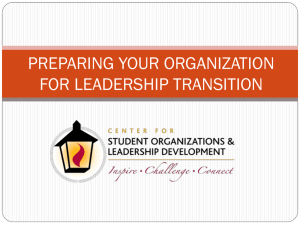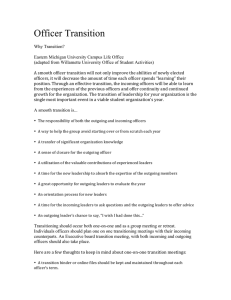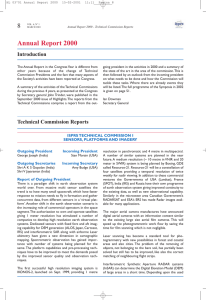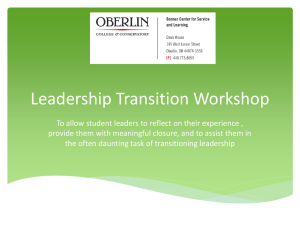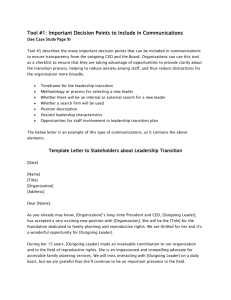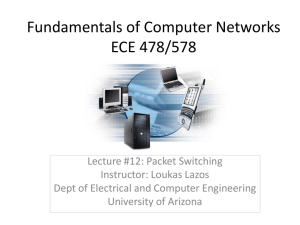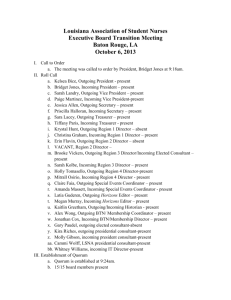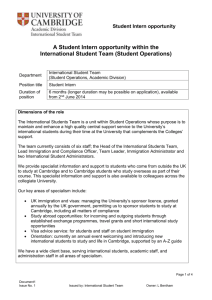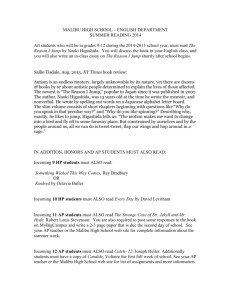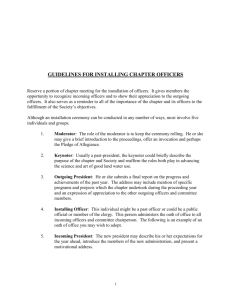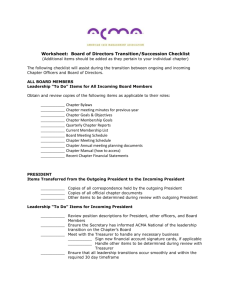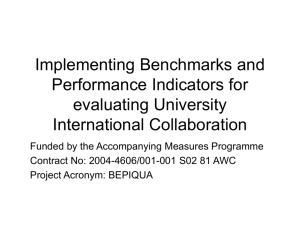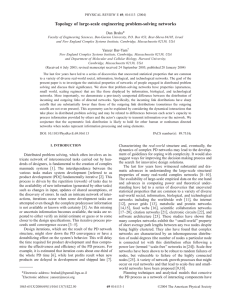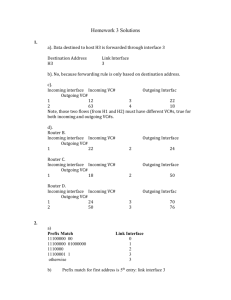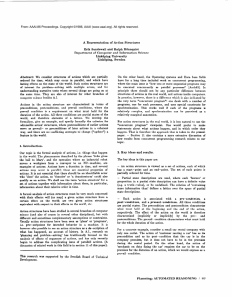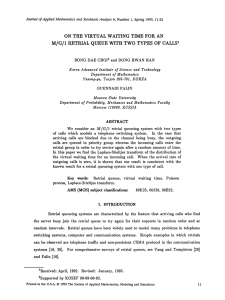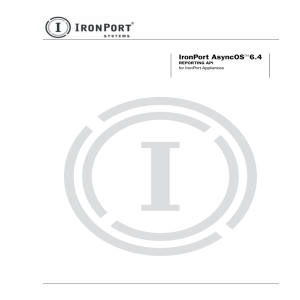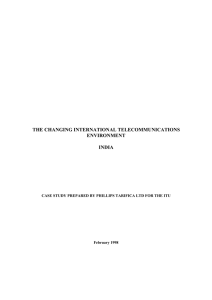Leadership Transition Planning
advertisement
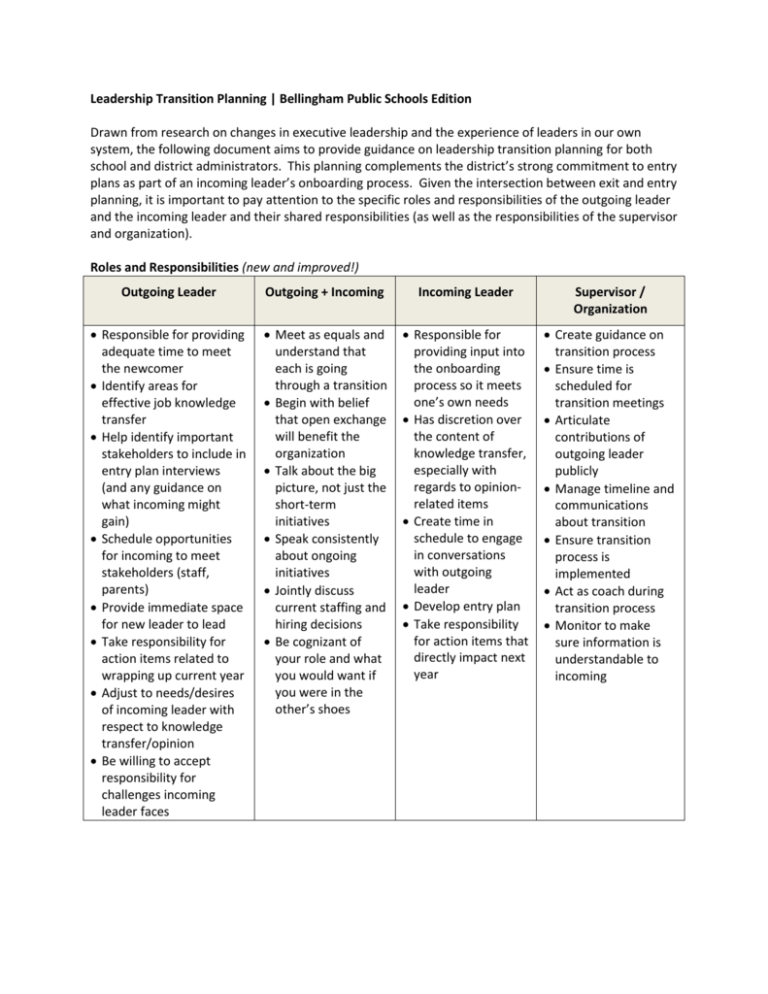
Leadership Transition Planning | Bellingham Public Schools Edition Drawn from research on changes in executive leadership and the experience of leaders in our own system, the following document aims to provide guidance on leadership transition planning for both school and district administrators. This planning complements the district’s strong commitment to entry plans as part of an incoming leader’s onboarding process. Given the intersection between exit and entry planning, it is important to pay attention to the specific roles and responsibilities of the outgoing leader and the incoming leader and their shared responsibilities (as well as the responsibilities of the supervisor and organization). Roles and Responsibilities (new and improved!) Outgoing Leader Outgoing + Incoming Incoming Leader Supervisor / Organization Responsible for providing adequate time to meet the newcomer Identify areas for effective job knowledge transfer Help identify important stakeholders to include in entry plan interviews (and any guidance on what incoming might gain) Schedule opportunities for incoming to meet stakeholders (staff, parents) Provide immediate space for new leader to lead Take responsibility for action items related to wrapping up current year Adjust to needs/desires of incoming leader with respect to knowledge transfer/opinion Be willing to accept responsibility for challenges incoming leader faces Meet as equals and understand that each is going through a transition Begin with belief that open exchange will benefit the organization Talk about the big picture, not just the short-term initiatives Speak consistently about ongoing initiatives Jointly discuss current staffing and hiring decisions Be cognizant of your role and what you would want if you were in the other’s shoes Responsible for providing input into the onboarding process so it meets one’s own needs Has discretion over the content of knowledge transfer, especially with regards to opinionrelated items Create time in schedule to engage in conversations with outgoing leader Develop entry plan Take responsibility for action items that directly impact next year Create guidance on transition process Ensure time is scheduled for transition meetings Articulate contributions of outgoing leader publicly Manage timeline and communications about transition Ensure transition process is implemented Act as coach during transition process Monitor to make sure information is understandable to incoming Knowledge Transfer: Technical and Adaptive Aspects The transfer of knowledge happens both through the documentation of work and dialogue about the role and work. As a group, we identified the scope of information/knowledge that would be important to transfer. Then we organized that information into 1) the more technical and “nuts and bolts” type of information that can be more easily documented and transferred with relatively little additional information needed and 2) the more adaptive and opinion-related information that can be addressed through conversations. Interviews and conversations convey the relational knowledge that is needed better than a written account on one’s work alone: “Stories transfer more of the knowledge than bullet points.” Some information should likely be conveyed through both formats. Leaders who do not already have a rapport may benefit from starting with factual information before moving more gradually into matters of opinion and judgment. We agreed that multiple conversations will likely necessary because of the breadth and depth of information to share and the nature of gaining understanding over time and with experience. Finally, we agreed that the incoming leader likely should have ultimate discretion in what they receive as knowledge from the outgoing with respect to opinion/judgment issues. Technical and Logistical Information 1. Acronyms – define them! 2. Budgets (attention to context-specific nuances and time-sensitive considerations) 3. Data a. School Demographics b. Student Achievement Data (OSPI report card, state test data, local data) 4. Email lists 5. Existing Strategic Plan 6. Facilities Information a. Keys b. Emergency Plans 7. Grants (attention to relevant reporting expectations and deadlines) 8. Location of working files (hard and electronic files) a. List important historical/reference documents to reference/be retained 9. Master and Other Schedules 10. Personnel Management a. Staff list and contact information (including summer contact details) b. Staffing assignments and open positions c. Team/organizational structure d. Existing decision matrix e. Personnel files (evaluations?); plans for improvement 11. Project Status Reports of all current, outstanding, and important upcoming projects a. Include deadlines, tasks and any special concerns (budget, stakeholders, safety) b. Highlight important unfinished projects to consider 12. Stakeholders a. PTA/Parent leaders (names, contact information) b. Community partners (names, contact information, relevant projects) c. Other relevant internal and external stakeholders 13. School Annual Events Calendar (attention to traditions and community expectations) 14. School Communications (newsletter, School Messenger, website) 15. Written Norms and Team Agreements Adaptive, Big-Picture and Opinion-Related Information 1. Finding out about the “load-bearing walls,” the “sacred cows,” and the “land mines” a. What in-progress initiatives are most vital? Why? b. What commitments have been made on them? c. Which unfinished projects should be focused on? d. What should or could be done on them? e. Are there quick win opportunities/low-hanging fruit to take advantage of? f. What initiatives or programs could be halted without harm to the core? g. Are there any legal processes underway to be aware of? 2. Getting to know the people a. Discuss staffing assignments and open positions. b. Are there any special considerations with regard to staff (e.g. known health issues)? c. Who are the go-to people in the building for questions? For advice? For assistance? d. What to do with staff evaluations (question about whether to share them at all)? e. Discuss of staff with existing plans for improvement. f. Who are the PTA/parent leaders and community partners and what are the dynamics of those relationships? 3. Getting to know the culture/identity a. What are the values that drive decisions and actions for this building/department? b. What are the school’s/organization’s traditions? c. What are the norms and team agreements? d. What are the stories beneath the demographics and the data (e.g. high-impact kids in schools with low overall poverty rates, test scores that deviate from other achievement data, etc.) 4. Getting to know the new environment a. Do a walk-through of the facility together to help surface site-specific items that may not arise in other conversations Additional Sources Friel, T.J. and Duboff, R.S. (January 2009). The Last Act of a Great CEO. Harvard Business Review, accessed at https://hbr.org/2009/01/the-last-act-of-a-great-ceo Hargreaves, A. and Fink, D. (December, 2003). The Seven Principles of Sustainable Leadership. Educational Leadership, accessed at http://jotamac.typepad.com/jotamacs_weblog/files/seven_principles.pdf Kelly, K. (2001). Passing the Torch: 5 Steps for Turning the Baby Boomer Brain Drain into a Brain Trust. UNC KenanFlagler Business School. Accessed at: http://www.kenan-flagler.unc.edu/executive-development/customprograms/~/media/Files/documents/executive-development/passing-the-torch.ashx Kerrigan, H. (September 2011). “Expert Interviews Instead of Exit Interviews,” Governing. Accessed at http://www.governing.com/columns/expert-interviews-instead-exit-interviews.html MacMillan, D. (August 2008). “Issue: Retiring Employees, Lost Knowledge,” Bloomberg Business. Accessed at: http://www.bloomberg.com/bw/stories/2008-08-20/issue-retiring-employees-lost-knowledgebusinessweekbusiness-news-stock-market-and-financial-advice Northeastern University’s Off-Board Toolkit: http://www.northeastern.edu/hrm/pdfs/resources/employment/offboarding_toolkit_8_2014.pdf
